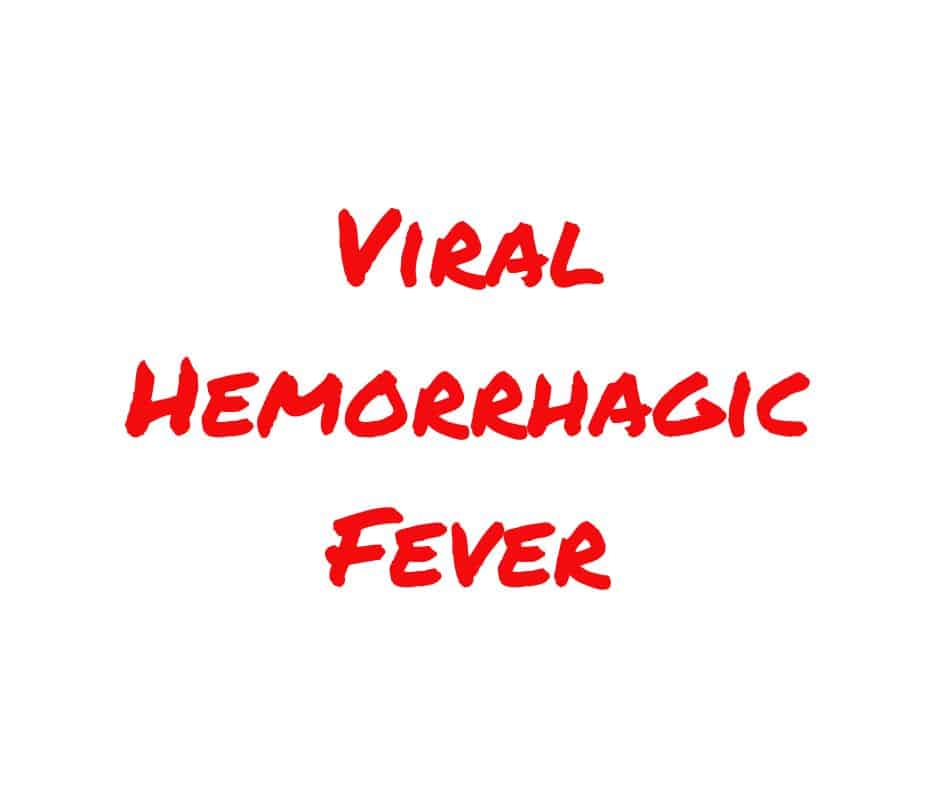What is Viral Hemorrhagic Fever?
Viral hemorrhagic fever is shortly known as VHF. Several different viruses can cause this VHF and affects multiple organs in the body. This disease affects body’s vascular system and may associate with hemorrhage (bleeding).
With various diseases you can find, Viral Hemorrhagic Fever. They are:
- Lassa fever
- Ebola fever
- Marburg fever
- Dengue
- Yellow fever
- Kyasanur fever
- Rift Valley fever
- Crimean–Congo hemorrhagic fever
- Bolivian hemorrhagic fever
- Argentinian hemorrhagic fever
- Hemorrhagic fever with renal syndrome (Hantaan fever)
- Venezuelans hemorrhagic fever
- Alkhumra hemorrhagic fever
Among all these, some of viral fever are mild and some are severe and life-threatening. Ebola fever and Marburg fever are an example of severe and life-threatening viral hemorrhagic fever.
Types of Viral Hemorrhagic Fever
Viral hemorrhagic fever is mainly of two types:
- Biosafety Level -4 viral hemorrhagic fever
- Non-Biosafety Level -4 viral hemorrhagic fever
Biosafety Level -4 viral hemorrhagic fever includes Lassa fever, Argentinian hemorrhagic fever, Bolivian hemorrhagic fever, Venezuelans hemorrhagic fever, Ebola fever, Marburg fever, Rift Valley fever, Crimean–Congo hemorrhagic fever and Hemorrhagic fever with renal syndrome (Hantaan fever).
Whereas, Non-Biosafety Level -4 viral hemorrhagic fever includes Dengue and Yellow fever.
Causes of Viral Hemorrhagic Fever
VHF is caused by various viruses. They are mainly:
- Arenaviruses
- Filoviruses
- Bunyaviruses
- Flaviviruses
These all are RNA (Ribonucleic Acid) viruses. These all RNA viruses are covered by lipid. Here, Humans are not the host for viruses.
Humans are infected by the causative host that is monkeys. Yes, monkeys are the primary host for viral hemorrhagic fever causing viruses. Yes, there are other hosts, but monkeys are the principle.
Arenaviruses are responsible for Lassa fever, Argentinian hemorrhagic fever, Bolivian hemorrhagic fever, Venezuelans hemorrhagic fever.
Filoviruses are responsible for Ebola fever and Marburg fever.
Bunyaviruses are responsible for Rift Valley fever, Crimean–Congo hemorrhagic fever, Hemorrhagic fever with renal syndrome (Hantaan fever).
Flaviviruses are responsible for Dengue and Yellow fever.
Causative hosts for VHF
Basically, what is the host? The host is also known as Reservoir. You know the meaning of Host or Reservoir, that is to hold or to store. So here, the following hosts reserve the viruses and transmit the viruses to other. So, hosts or reservoir means they have the causative agents and may transmit the infections to other.
Hosts for:
- Lassa fever are Multimammate rats (Mastomys natalensis).
- Ebola fever or Ebola virus and Marburg fever are still unknown. And that is the reason, Ebola fever or Ebola virus and Marburg fever are severe and life-threatening.
- Dengue are Humans.
- Yellow fever and Kyasanur fever are monkeys.
- Rift Valley fever are farm animals.
- Crimean–Congo hemorrhagic fever are vertebrate, farmed and wild animals.
- Bolivian hemorrhagic fever, Argentinian hemorrhagic fever, Hemorrhagic fever with renal syndrome (Hantaan fever) and Venezuelans hemorrhagic fever are rodent animals.
- Alkhumra hemorrhagic fever are rodent animals, sheep, goat, and mosquitoes.
Signs and Symptoms of VHF
Initial signs and symptoms of viral hemorrhagic fever are:
- Fever
- Fatigue
- Malaise
- Muscle ache
- Headache
- Sore throat
- Dizziness
Severe signs and symptoms of viral hemorrhagic fever are:
- Bleeding
- Hypovolemic shock
- Nervous system failure
- Seizures
- Coma
- Acute respiratory distress syndrome
- Renal failure
- Inflammation of one or both testicles
- Blindness
- Pulmonary edema
In severe VHF, you can see Hemorrhage (bleeding) from internal organs, skin, mouth, ears, eyes, etc. Whereas, you can find pain in Lassa fever.
Transmission of Hemorrhagic Fever Viruses
Viruses responsible for hemorrhagic fever are mainly transmitted to the humans. When the hosts come in contact with Humans, they transmit the viruses causing the hemorrhagic fever to Humans.
In Lassa fever, Ebola fever or Ebola virus, Marburg fever, Crimean–Congo hemorrhagic fever the infection is transmitted from one infected person to another person through direct contact, contact with infected objects or body fluids exchange.
These type of viral infection is mainly spread through the use of contaminated blood, syringes and needles.
Diagnosis of Viral Hemorrhagic Fever
A person with the history of travel more than 21 days in exposure area and has fever must undergo for diagnosis of VHF.
Laboratory tests are done in high-grade laboratories with biosafety. Blood reports show low total white blood cell counts mainly lymphocytes, low platelet counts.
Other reports shows, and high blood serum liver enzymes. High Prothrombin Time (PT) and Partial Thromboplastin Time (PTT). There is increase bleeding time. (Source: Wikipedia)
Some test for VHF are:
- Blood test
- Throat swab test
- Urine test
- Body fluids test
- PCR (Polymerase Chain Reaction) test
- Virus isolation test
- Serology test
Treatment of Viral Hemorrhagic Fever
Unfortunately, there is no specific cure or treatment is available for viral hemorrhagic fever.
But, antiviral drug – Ribavirin is used to treat Lassa fever and Hemorrhagic fever with renal syndrome (Hantaan fever) with some good results.
Ribavirin is given intravenously (I.V.) with a dose of 100 mg/kg followed by 25 mg/kg for 3 days and 12.5 mg/kg daily for 4 days. (Source: Davidson’s Principles and Practice of Medicine, 21st edition).
Risk factors for VHF
Traveling, regional activities, contact with the animals in the exposure area within 21 days, put you at the higher risk of VHF.
You must avoid area exposed to Ebola virus infection as it can be life-threatening. Have knowledge of routinely exposing areas with VHF viruses.
Some regions are Congo, Uganda, Sudan, Kyasanur forest (Karnataka), Turkey, Russia, Balkans, etc.
Prevention of VHF
Prevention of VHF is must important factor for your life because only two of the all VHF diseases are having vaccines whereas, vaccines for rest are not available.
Vaccines are available for Yellow fever and Argentinian hemorrhagic fever.
- Be careful and avoid contact with the hosts as you can get transmitted by them.
- Stay away from above-described hosts to avoid VHF.
- Wear full sleeve clothes.
- Use insect repellant, bed nets, and window nets.
- Avoid insect bites.
- Use of disinfectants.
- Proper disposal of syringe and needles.
- Avoid transfer of infected blood.
- Avoid travel to the exposure area.
If you find yourself get infected, please stop spreading to another person for humanity.
Conclusion
Don’t let VHF commands over you. Be careful, take preventive measures and conquer over Viral Fever Hemorrhage.






















